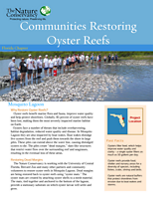The Mosaic Company
Improving Water Quality, and Protecting and Restoring Coastal Areas
It’s simple. If we are to feed the world’s growing population we must produce more food. Today, nearly a billion of the world’s seven billion people are chronically hungry, and the world’s population is estimated to grow to 9 billion by 2050. In order to feed this many people, experts estimate that we may need to grow at least two times that which is produced today, in part because rising income levels increase demand for products like meat that have large agriculture “footprints.” The key is that we must do this sustainably, without destroying the very natural resources that sustain life on Earth. Natural resources like the forests that clean the air we breathe. Or the water we drink and that grows our food and is needed to make the products that fuel our economies.
The Sustainable Solution
There is, however, a sustainable solution to this great challenge we face together. We must produce more food on existing agricultural lands and do so without degrading water quality or other natural resources that sustain life. Such a solution is not only sustainable, it is attainable. Fertilizers are already responsible for 40 to 60 percent of crop yields. Although these yields are impressive, it is important that we take agricultural productivity to the next level by utilizing science-based innovations and best management practices that close ‘yield gaps’ on underperforming lands and increase crop efficiency.
This is the vision The Nature Conservancy shares with global agribusinesses like The Mosaic Company. Mosaic is the world’s leading producer of concentrated phosphate and potash – essential minerals in crop nutrients that help farmers around the world produce more food per acre.
Reducing Agriculture’s Impact on Water
The Mosaic Company Foundation’s $720,000 grant to TNC's Great Rivers Partnership (GRP) illustrates Mosaic’s commitment to precision conservation practices that address nutrient and sediment run-off in agricultural landscapes. While crop nutrients are essential to feeding the world, the right source must be applied at the right time, in the right place and in the right rate to mitigate the potential for nutrient runoff. All farms, large and small, must employ best management practices to protect water supplies and water habitats.
The Foundation’s grant is helping fund TNC’s work with partners and farmers to keep valuable nutrients and soil on farm fields and out of streams. Specifically, the grant is funding work at three river basins, or watersheds, in the Upper Mississippi River region – at the Root River in Minnesota, the Boone River in Iowa and the Mackinaw River in Illinois. These rivers represent three of the five demonstration sites in the Upper Mississippi where TNC is helping test innovative practices that can maintain and increase crop yields while improving water quality. These demonstration sites are part of a three-year pilot launched in 2009 with support from several agribusiness industry leaders.
While in-stream monitoring at these demonstration sites reveals promising results, the ultimate goal isn’t to improve water in these rivers alone – or even the Mississippi River and downriver in the Gulf. The ultimate goal is to demonstrate success at these sites to influence agricultural practices throughout the Mississippi River Basin, across the nation and eventually around the globe.
A good start in helping achieve this goal was the creation of the Mississippi River Basin Initiative (MRBI) in 2009. The MRBI is part of the U.S. Farm Bill, which provides the single largest source of funding for conservation in the nation. The four-year, $320-million, 13-state initiative directs conservation funding at those watersheds in the Mississippi River basin that contribute the largest volume of nutrients. Money from the MRBI has helped fund the adoption of new management practices in each of the GRP’s five demonstration sites in the Upper Mississippi, thus leveraging investments from companies like Mosaic that contribute private dollars. Furthermore, innovations tested at the projects Mosaic supports have influenced and help expand successful practices throughout many of the watersheds targeted by the MRBI.
Improving Coastal Health
A separate $300,000 grant from The Mosaic Company Foundation to TNC is funding work that has multiple benefits for Florida’s Charlotte Harbor, home to 86 of Florida’s endangered and threatened species. The Charlotte Harbor watershed, which has long been recognized as an important estuary and key contributor to the health of the broader ecosystem in the Gulf, is America’s 17th largest estuary and Florida’s 2nd largest open-water estuary.
The partnership supports TNC's work with the local community to develop a science-based, whole-estuary oyster reef restoration plan and initiate a demonstration site that will serve as a model for future large-scale restoration throughout suitable areas in the Charlotte Harbor and the Gulf. Because oysters filter water when feeding – up to 50 gallons per oyster each day – they can help improve water quality. Oyster reefs also provide important food, shelter and nursery areas for other wildlife, like birds, fish, shrimp and crabs, and they help protect shorelines from erosion and storm surges.
In addition to restoration, TNC is working with communities in Charlotte Harbor to help them adapt to coastal hazards. Healthy coastal habitats, like marshes, wetlands and reefs, help reduce damages to communities caused by storm surges, erosion and flooding. TNC's work is supported by a grant from a NOAA/SeaGrant partnership. Studies have shown that every dollar invested in hazard mitigation results in four dollars of cost savings. Key to this effort are community planning workshops as well as information from a web-based decision support tool developed by TNC that can help guide conservation and restoration efforts at Charlotte Harbor, and throughout the Gulf Coast region.

